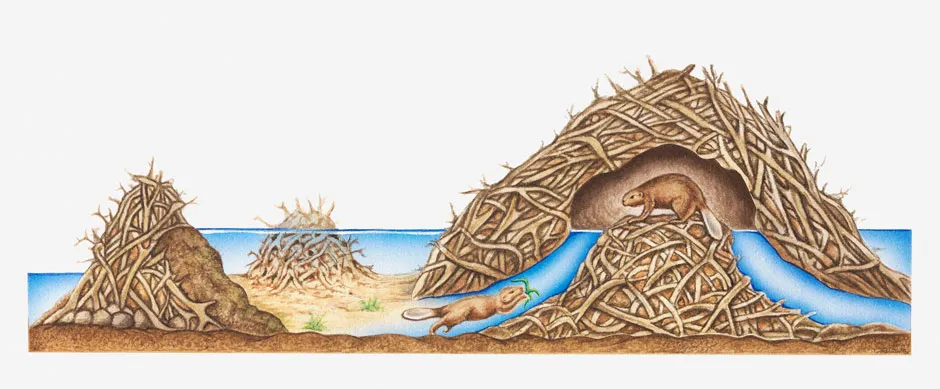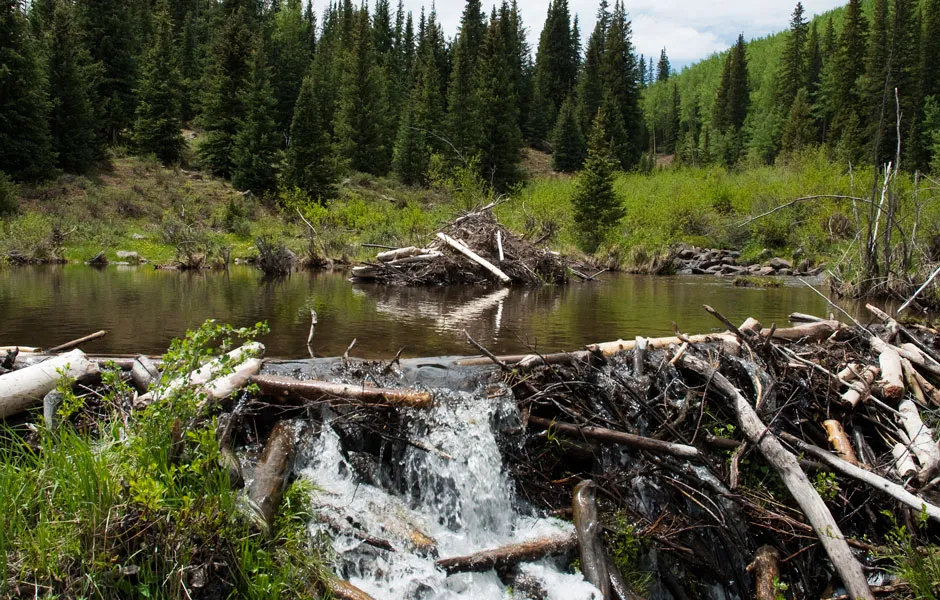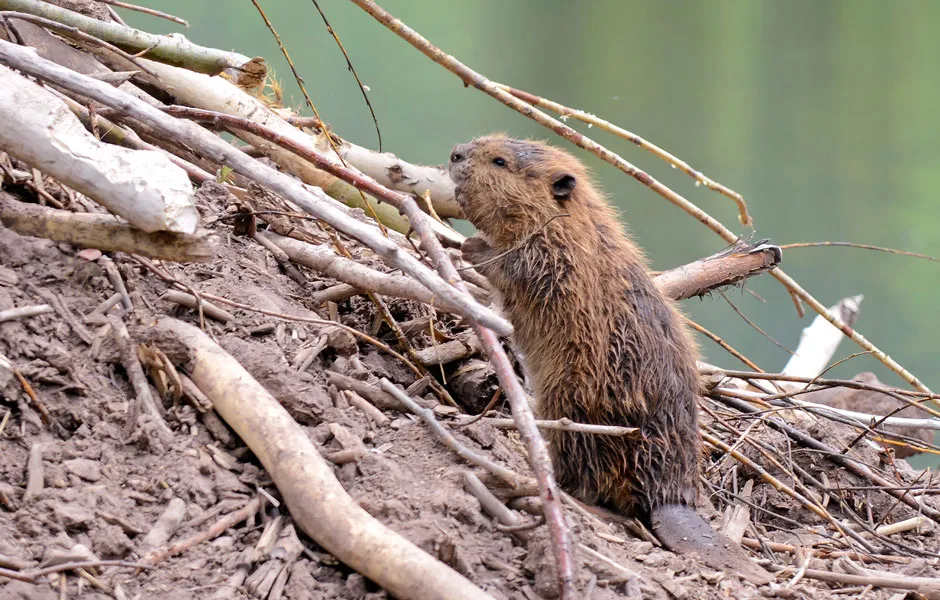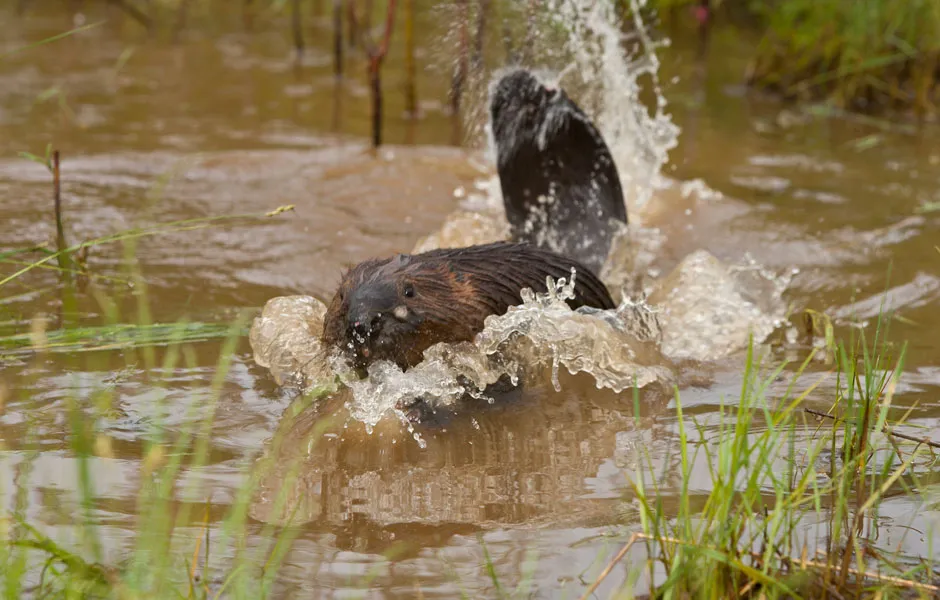Beavers. If you know anything about them, it’s that they’re brilliant builders, capable of engineering the most complex riverside structures – no crane or hard hat required. But why do beavers build dams in the first place?
Answer: Beavers build dams to protect themselves from predators, such as bears or wolves. Beavers don’t actually live in the dams, but in the deep pond of water that dams create.
In this pool, beavers construct their real home: a small protective island or dome ‘lodge’ that serves as a dry living area and food store.
Not only are these ponds deep enough to deter land animals, but they also allow beavers to dig underwater entrances into the lodge. This means that if danger emerges, they can safely exit or escape through these tunnels.

Lodges in the UK can be a whole 10m across, requiring dams around 100m in width. The world's biggest dam – discovered in Alberta, Canada – measures a massive 500m in length and could get several hundred meters longer if it connects with nearby dams in future. Contrary to myth, however, it can’t actually be seen from space.
Interestingly, while these structures guard beavers against large predators in other parts of the world, they’re often not put to the test in the UK. Why? Well, there aren’t really any large predators left.
“From brown bears, to wolves, to wolverines: they’ve all basically been killed off in this country,” explains Richard Brazier, Professor of Earth surface processes at the University of Exeter. “But despite that, beavers are still innately driven to create deep water dams to feel safe.”

So, with the basics covered, chances are you’re now poised with a stream of related questions. From how long dams last for, to what food beavers eat inside their lodges, you can find a (river)bank of answers below.
What do beavers eat?
As you might have guessed, The Lion, the Witch and the Wardrobe got it completely wrong: beavers don’t eat fish and chips. Not even on Fridays.
“Although otters eat fish, beavers are herbivores – they generally just eat the leaves of trees such as willows and aspens,” says Brazier.
“Beavers sometimes also strip trees of bark and eat that. Overall, they’re pretty adaptable and can consume most aquatic plants and vegetation.”
After finding food, beavers have a clever way of creating a shortcut back home. Having located a particularly scrumptious willow tree, for instance, a beaver may dig out a small canal through the riverbank that leads straight back to their dam.
“This means after reaching the tree they’re interested in, beavers can then strip a branch and float it back along the canal for later,” explains Brazier. “It’s quite ingenious really.”
How many beavers live in a dam?
There’s no set number – a dam and lodge could hold anything from a pair of beavers to 10. However, generally, only one family of beavers live in one area (they’ll even fight other families that wander into their territory).
Interestingly, one dam can host generations of beavers, with lodges standing as long as beavers are active in the region. For example, although beavers live for eight years on average, it’s believed the aforementioned dam in Alberta was first constructed in 1970.
Do beavers hibernate?
Like many other rodents, no, beavers do not hibernate. But they do meticulously prepare for long winter months. In fact, just in case they get frozen into their pond, beavers create a food store below their lodge.
“If the pond freezes and the beavers are effectively stuck there, they’ll rely on their underwater food larder,” explains Brazier. “They can swim out of the lodge’s underwater exit, pick up some willow from their stash and bring it back upstairs.”
Beavers not only spend more time in their lodge to escape the cold during this time, but also to nurse their newborns, who are normally birthed in winter. And just in case you’re wondering: yes, they are extremely cute.

What happens if the water level rises too far in winter and the lodge gets flooded? Beavers will just build another layer on top.
“Beavers have been known to build lodges with five or even ten stories,” says Brazier. “This can be very useful: often the lower water levels are used by baby beavers to practice swimming, away from outside dangers.”
Are beavers nocturnal?
Yes, beavers are nocturnal. This probably explains why you haven’t seen any during your riverside treks.
“Normally, they only actually leave their lodge to start grooming and feeding at about 7:00pm in the evening. They’ll then find more food, mark their scent and check their territory’s boundaries for the next 12 hours,” says Brazier. “At around seven in the morning, they’ll go inside the lodge to eat and sleep.”
So, why are beavers nocturnal? Like most night-time animals, this behaviour helps them avoid predators. However, with most of their predators now extinct in the UK, resident beavers are only truly nocturnal out of habit.
“This means UK beavers could potentially evolve into daylight animals, but these changes will take a long long time,” Brazier says. “Remember: they are creatures who have been evolving for millions and millions of years and they’re likely to have been nocturnal animals for that entire time.”
Why do beavers slap their tails on the water?
Wild beavers slap their tails because they feel threatened. No, they’re not just showing off. Or trying to splash you.
Just like how a rabbit thumps against the ground to warn its burrow, a beaver will slap the water with its tail to alert others before diving under. Any family member to hear the splash will likely return to the water too.

“This is why if you’re lucky enough to see any signs of beavers – think chewed timber – you should be very quiet and move very slowly,” says Brazier.
“If you can see a water line, keep your eyes peeled and look for big ripples. And be patient – it really will be worth it!”
Do you have any other great beaver facts?
Glad you asked. Over time, beavers have evolved to have a handy comb on their back foot. On their right side, one of their claws has a cleft or split in the middle, which comes especially useful when grooming.
“This inbuilt comb is an easy way of keeping a beaver’s fur clean. And it’s not just a matter of hygiene: dirty fur is actually one of the biggest killers of beavers. That’s simply because clean fur is waterproof and warm,” explains Brazier.
Just remember: although it works for beavers, we absolutely cannot recommend growing your nails in the same way. Just think of what your mum would say about it.
About our expert
Richard Brazier is a professor of physical geography at the University of Exeter. Among other areas, he studies the reintroduction of Beavers in the southwest of England, particularly how the animals modify the landscape. His work has been published in journals including the Journal of Applied Ecology, Restoration Ecology and Ecological Solutions And Evidence.
Read more: